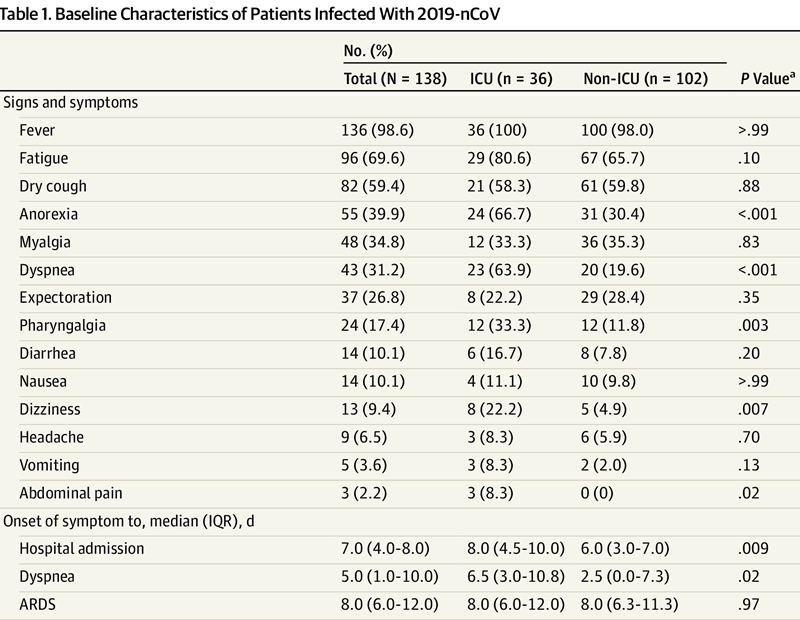Coronavirus Symptoms (COVID-19)
People with COVID-19 have had a wide range of symptoms reported – ranging from mild symptoms to severe illness. These symptoms may appear 2-14 days after exposure to the virus:
- Fever
- Cough
- Shortness of breath or difficulty breathing
- Chills
- Repeated shaking with chills
- Muscle pain
- Headache
- Sore throat
- New loss of taste or smell
Typical Symptoms
COVID-19 typically causes flu-like symptoms including a fever and cough.
In some patients - particularly the elderly and others with other chronic health conditions - these symptoms can develop into pneumonia, with chest tightness, chest pain, and shortness of breath.
It seems to start with a fever, followed by a dry cough.
After a week, it can lead to shortness of breath, with about 20% of patients requiring hospital treatment.
Notably, the COVID-19 infection rarely seems to cause a runny nose, sneezing, or sore throat (these symptoms have been observed in only about 5% of patients). Sore throat, sneezing, and stuffy nose are most often signs of a cold.
Examples of possible development of symptoms (from actual cases)
A man in his 40s in Japan:
- Day #1: malaise and muscle pain
- later diagnosed with pneumonia
A man in his 60s in Japan:
- Day #1: initial symptoms of low-grade fever and sore throat.
A man in his 40s in Japan:
A woman in her 70s, in Japan:
- Day #1: 38° fever for a few minutes
- Day #2-3: went on a bus tour
- Day #5: visited a medical institution
- Day #6: showed symptoms of pneumonia.
A woman in her 40s, in Japan:
- Day #1: low-grade fever
- Day #2: 38° fever
- Day #6: being treated at home.
A man in his 60s, in Japan:
- Day #1: Cold
- Day #6: Fever of 39° C. (102.2 F)
- Day #8: Pneumonia
How long do symptoms last?
Using available preliminary data, the Report of the WHO-China Joint Mission published on Feb. 28 by WHO, [5] which is based on 55,924 laboratory confirmed cases, observed the following median time from symptoms onset to clinical recovery:
- mild cases: approximately 2 weeks
- severe or critical disease: 3 - 6 weeks
- time from onset to the development of severe disease (including hypoxia): 1 week
Among patients who have died, the time from symptom onset to outcome ranges from 2 - 8 weeks
Information on Coronavirus Symptoms from Government Health Officials
Canada Public Health Agency
The Canadian PHAC section dedicated to the 2019 novel coronavirus states that:
- You may have little to no symptoms.
- You may not know you have symptoms of COVID-19 because they are similar to a cold or flu.
- Symptoms may take up to 14 days to appear after exposure to the virus. This is the longest known infectious period for this virus.
Symptoms have included:
- fever
- cough
- difficulty breathing
- pneumonia in both lungs
In severe cases, infection can lead to death.
UK Government and NHS
The UK National Health Service (NHS) section dedicated to Coronavirus (2019-nCoV) lists the following as the main symptoms of coronavirus:
- a cough
- a high temperature
- shortness of breath
The GOV.UK novel coronavirus guidance for the public page says:
- Typical symptoms of coronavirus include fever and a cough that may progress to a severe pneumonia causing shortness of breath and breathing difficulties.
The GOV.UK clinical guidance on Novel coronavirus (2019-nCoV): epidemiology, virology and clinical features notes that:
- Fever, cough or chest tightness, and dyspnoea are the main symptoms reported. While most cases report a mild illness, severe are also being reported, some of whom require intensive care.
Australian Government
The Australian Government Department of Health informs that symptoms can range from mild illness to pneumonia, adding that some people will recover easily, while others may get very sick very quickly. According to their list of novel coronavirus symptoms, people may experience:
- fever
- flu-like symptoms such as coughing, sore throat and fatigue
- shortness of breath
Symptoms observed in hospitalized patients with COVID-19
Below we list the symptoms, with percentages representing the proportion of patients displaying that symptom, as observed in hospitalized patients tested and identified as having laboratory-confirmed COVID-19 infection. These findings refer to hospitalized patients, therefore generally representing serious or critical cases. The majority of cases of COVID-19 (about 80%) is mild.Findings from the Wang et al study published on JAMA and based on 138 hospitalized patients
Common symptoms included: (Wang et al study) | |
Fever | 98.6% |
Fatigue | 69.6% |
Dry cough | 59.4% |
The median time observed:
- from first symptom to → Dyspnea (Shortness of breath) = 5.0 days
- from first symptom to → Hospital admission = 7.0 days
- from first symptom to → ARDS (Acute Respiratory Distress Syndrome) = 8.0 days (when occurring)
Full list of symptoms from the Wang study:
Findings from the Huang et al study published on The Lancet and based on 41 hospitalized patients
COMMON SYMPTOMS AT ONSET OF ILLNESS (Huang et al study) | |
Fever | 98% |
Cough | 76% |
Myalgia (muscle pain) or Fatigue | 44% |
LESS COMMON SYMPTOMS: | |
Sputum production (coughing up material) | 28% |
Headache | 8% |
Haemoptysis (coughing up blood) | 5% |
Diarrhea | 3% |
Findings from the Chen et al study published on The Lancet and based on 99 hospitalized patients [4]




